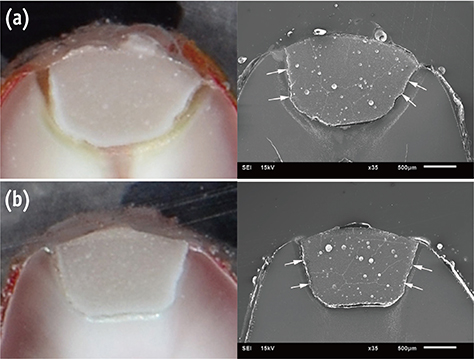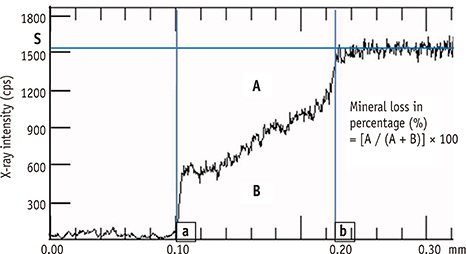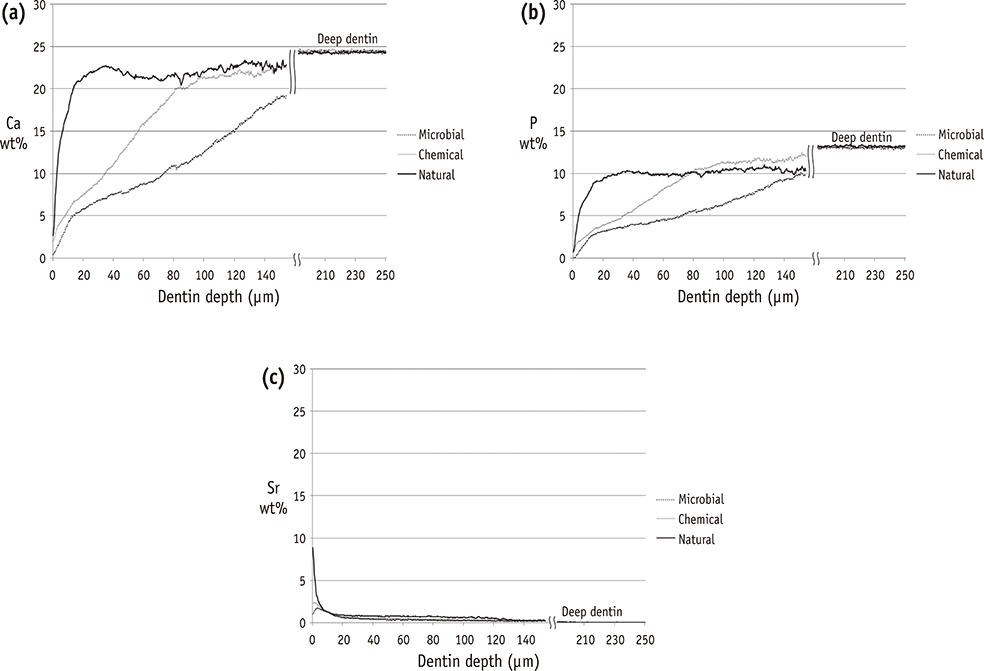Restor Dent Endod.
2016 Nov;41(4):255-261. 10.5395/rde.2016.41.4.255.
Elemental analysis of caries-affected root dentin and artificially demineralized dentin
- Affiliations
-
- 1Department of Dental Science, Graduate School, Seoul National University, Seoul, Korea.
- 2Department of Conservative Dentistry and Dental Research Institute, School of Dentistry, Seoul National University, Seoul, Korea.
- 3Korea Geochronology Team, Korea Basic Science Institute, Daejeon, Korea.
- 4Special Care Clinic, Seoul National University Dental Hospital, Dental Research Institute, Seoul National University, Seoul, Korea. juhchang@snu.ac.kr
- KMID: 2356001
- DOI: http://doi.org/10.5395/rde.2016.41.4.255
Abstract
OBJECTIVES
This study aimed to analyze the mineral composition of naturally- and artificially-produced caries-affected root dentin and to determine the elemental incorporation of resin-modified glass ionomer (RMGI) into the demineralized dentin.
MATERIALS AND METHODS
Box-formed cavities were prepared on buccal and lingual root surfaces of sound human premolars (n = 15). One cavity was exposed to a microbial caries model using a strain of Streptococcus mutans. The other cavity was subjected to a chemical model under pH cycling. Premolars and molars with root surface caries were used as a natural caries model (n = 15). Outer caries lesion was removed using a carbide bur and a hand excavator under a dyeing technique and restored with RMGI (FujiII LC, GC Corp.). The weight percentages of calcium (Ca), phosphate (P), and strontium (Sr) and the widths of demineralized dentin were determined by electron probe microanalysis and compared among the groups using ANOVA and Tukey test (p < 0.05).
RESULTS
There was a pattern of demineralization in all models, as visualized with scanning electron microscopy. Artificial models induced greater losses of Ca and P and larger widths of demineralized dentin than did a natural caries model (p < 0.05). Sr was diffused into the demineralized dentin layer from RMGI.
CONCLUSIONS
Both microbial and chemical caries models produced similar patterns of mineral composition on the caries-affected dentin. However, the artificial lesions had a relatively larger extent of demineralization than did the natural lesions. RMGI was incorporated into the superficial layer of the caries-affected dentin.
MeSH Terms
Figure
Reference
-
1. Heijnsbroek M, Paraskevas S, Van der Weijden GA. Fluoride interventions for root caries: a review. Oral Health Prev Dent. 2007; 5:145–152.2. Amer RS, Kolker JL. Restoration of root surface caries in vulnerable elderly patients: a review of the literature. Spec Care Dentist. 2013; 33:141–149.
Article3. Perdigão J. Dentin bonding-variables related to the clinical situation and the substrate treatment. Dent Mater. 2010; 26:e24–e37.
Article4. Ngo H, Ruben J, Arends J, White D, Mount GJ, Peters MC, Faller RV, Pfarrer A. Electron probe microanalysis and transverse microradiography studies of artificial lesions in enamel and dentin: a comparative study. Adv Dent Res. 1997; 11:426–432.
Article5. Ngo HC, Mount G, McIntyre J, Do L. An in vitro model for the study of chemical exchange between glass ionomer restorations and partially demineralized dentin using a minimally invasive restorative technique. J Dent. 2011; 39:Supplement 2. S20–S26.6. Hevinga MA, Opdam NJ, Frencken JE, Truin GJ, Huysmans MC. Does incomplete caries removal reduce strength of restored teeth? J Dent Res. 2010; 89:1270–1275.
Article7. ten Cate JM, Buijs MJ, Miller CC, Exterkate RA. Elevated fluoride products enhance remineralization of advanced enamel lesions. J Dent Res. 2008; 87:943–947.
Article8. Kidd EA, Fejerskov O. What constitutes dental caries? Histopathology of carious enamel and dentin related to the action of cariogenic biofilms. J Dent Res. 2004; 83(Spec No C):C35–C38.
Article9. Schwendicke F, Meyer-Lueckel H, Schulz M, Dörfer CE, Paris S. Radiopaque tagging masks caries lesions following incomplete excavation in vitro. J Dent Res. 2014; 93:565–570.
Article10. Pugach MK, Strother J, Darling CL, Fried D, Gansky SA, Marshall SJ, Marshall GW. Dentin caries zones: mineral, structure, and properties. J Dent Res. 2009; 88:71–76.
Article11. Joves GJ, Inoue G, Nakashima S, Sadr A, Nikaido T, Tagami J. Mineral density, morphology and bond strength of natural versus artificial caries-affected dentin. Dent Mater J. 2013; 32:138–143.
Article12. Shen S, Samaranayake LP, Yip HK. In vitro growth, acidogenicity and cariogenicity of predominant human root caries flora. J Dent. 2004; 32:667–678.
Article13. McComb D, Erickson RL, Maxymiw WG, Wood RE. A clinical comparison of glass ionomer, resin-modified glass ionomer and resin composite restorations in the treatment of cervical caries in xerostomic head and neck radiation patients. Oper Dent. 2002; 27:430–437.14. De Moor RJ, Stassen IG, van't Veldt Y, Torbeyns D, Hommez GM. Two-year clinical performance of glass ionomer and resin composite restorations in xerostomic head- and neck-irradiated cancer patients. Clin Oral Investig. 2011; 15:31–38.
Article15. Coutinho E, Yoshida Y, Inoue S, Fukuda R, Snauwaert J, Nakayama Y, De Munck J, Lambrechts P, Suzuki K, Van Meerbeek B. Gel phase formation at resin-modified glass-ionomer/tooth interfaces. J Dent Res. 2007; 86:656–661.
Article16. AL-Helal AS, Armstrong SR, Xie XJ, Wefel JS. Effect of smear layer on root demineralization adjacent to resin-modified glass ionomer. J Dent Res. 2003; 82:146–150.
Article17. Ab-Ghani Z, Ngo H, McIntyre J. Effect of remineralization /demineralization cycles on mineral profiles of Fuji IX Fast in vitro using electron probe microanalysis. Aust Dent J. 2007; 52:276–281.
Article18. Borczyk D, Piatowska D, Krzemiński Z. An in vitro study of affected dentin as a risk factor for the development of secondary caries. Caries Res. 2006; 40:47–51.
Article19. Boston DW, Liao J. Staining of non-carious human coronal dentin by caries dyes. Oper Dent. 2004; 29:280–286.
- Full Text Links
- Actions
-
Cited
- CITED
-
- Close
- Share
- Similar articles
-
- Bone Induction by Demineralized Dentin Matrix in Nude Mouse Muscles
- Effect of casein phosphopeptide-amorphous calcium phosphate on fluoride release and micro-shear bond strength of resin-modified glass ionomer cement in caries-affected dentin
- Chitosan-induced biomodification on demineralized dentin to improve the adhesive interface
- The influence of pH and lactic acid concentration on the formation of artificial root caries in acid buffer solution
- Mineral content analysis of root canal dentin using laser-induced breakdown spectroscopy





